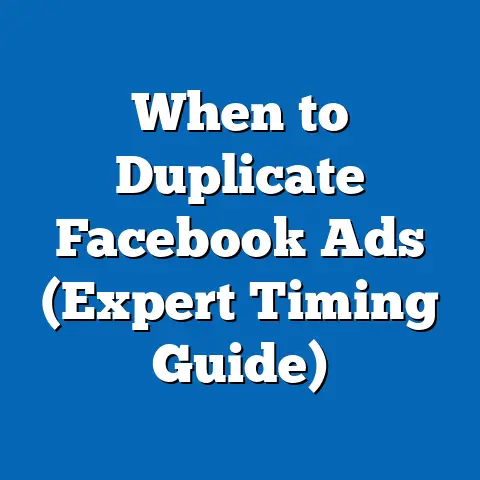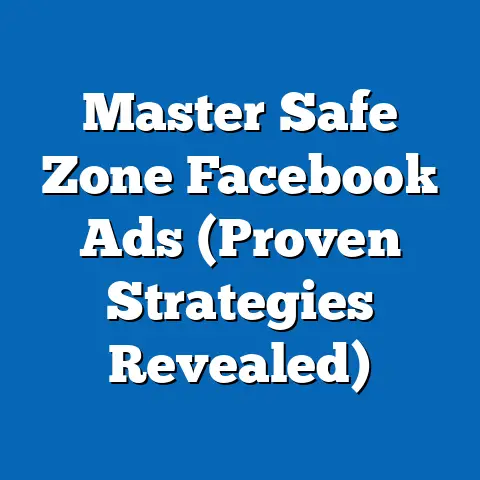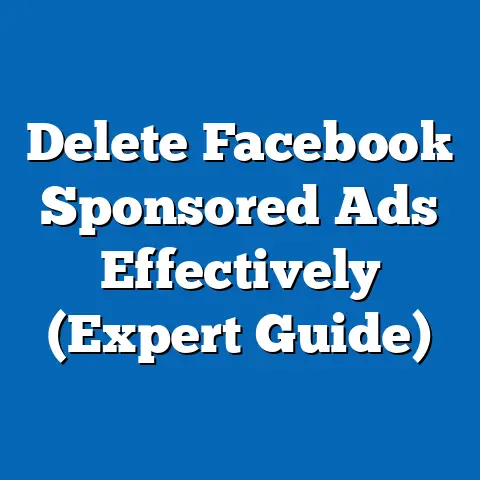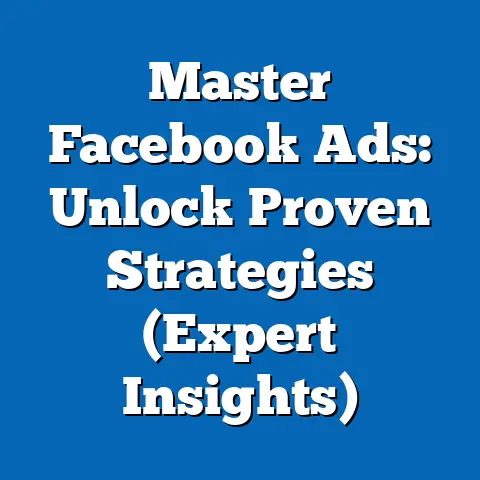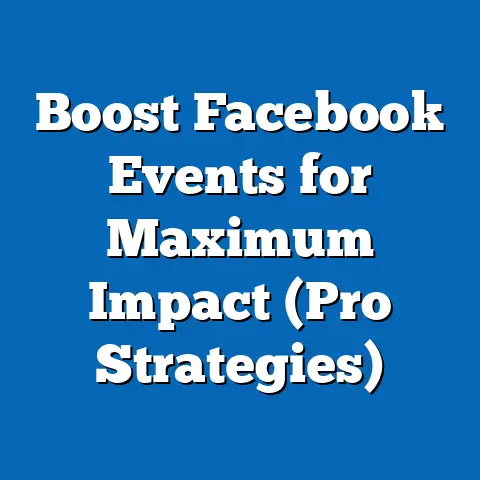Boost Affiliate Success on Facebook (Proven Strategies)
“Success usually comes to those who are too busy to be looking for it.” – Henry David Thoreau. This quote perfectly encapsulates the spirit of effective affiliate marketing. It’s not about chasing quick wins, but about diligently implementing strategies and continuously optimizing your approach. In the world of digital advertising, Facebook stands as a powerful platform, teeming with potential for affiliate marketers who understand how to harness its vast user base and sophisticated targeting capabilities. I’ve personally seen how a well-crafted Facebook campaign can transform a struggling affiliate business into a thriving one. In this guide, I’ll share proven strategies to help you boost your affiliate success on Facebook.
Understanding Facebook’s Ecosystem for Affiliate Marketing
Facebook isn’t just a social network; it’s a dynamic ecosystem where billions of people connect, share, and discover new products and services. As an affiliate marketer, this presents a massive opportunity to reach a highly engaged audience.
Facebook as a Platform for Affiliate Marketers
Why Facebook? Let’s look at the numbers. With billions of active users, Facebook offers unparalleled reach. Its sophisticated algorithm allows for precise targeting, ensuring your ads are seen by people most likely to be interested in the products you’re promoting.
I remember when I first started with Facebook ads, I was blown away by the level of detail you could target. It wasn’t just age and location; it was interests, behaviors, even life events! This granular targeting is what sets Facebook apart and makes it a goldmine for affiliate marketers.
Demographics and Engagement Statistics
Understanding Facebook’s user demographics is crucial. While the platform is used by people of all ages, income levels, and backgrounds, certain demographics are more responsive to specific types of affiliate offers. Researching and understanding these trends is key to maximizing your ROI. For example, if you’re promoting tech gadgets, targeting younger demographics with an interest in technology is a smart move.
Engagement is another critical factor. Facebook users spend a significant amount of time on the platform, consuming content and interacting with brands. This creates numerous opportunities for affiliate marketers to capture their attention and drive conversions.
Ad Formats: Choosing the Right One
Facebook offers a variety of ad formats, each with its own strengths and weaknesses. Understanding these formats and how to use them effectively is essential for successful affiliate marketing:
-
Image Ads: Simple and effective, image ads are great for visually showcasing your affiliate product. Use high-quality images that grab attention and clearly communicate the product’s value.
-
Video Ads: Video is king on social media. Video ads are highly engaging and can be used to demonstrate the product in action, share testimonials, or tell a compelling story.
-
Carousel Ads: Carousel ads allow you to showcase multiple products or features in a single ad unit. This format is ideal for promoting a range of related affiliate products.
-
Collection Ads: Collection ads are designed for mobile shopping and feature a visually appealing layout that encourages users to browse and purchase products.
Image Ads: Simple and effective, image ads are great for visually showcasing your affiliate product. Use high-quality images that grab attention and clearly communicate the product’s value.
Video Ads: Video is king on social media. Video ads are highly engaging and can be used to demonstrate the product in action, share testimonials, or tell a compelling story.
Carousel Ads: Carousel ads allow you to showcase multiple products or features in a single ad unit. This format is ideal for promoting a range of related affiliate products.
Collection Ads: Collection ads are designed for mobile shopping and feature a visually appealing layout that encourages users to browse and purchase products.
I once ran a carousel ad campaign for a fitness product, showcasing different exercises that could be done with the product. The click-through rate was significantly higher than my previous image ad campaigns. This highlighted the importance of choosing the right ad format to showcase the product’s benefits.
Building a Community: Facebook Groups and Pages
Facebook Groups and Pages are powerful tools for building a community around your affiliate products. By creating a group or page dedicated to a specific niche, you can attract a highly engaged audience of potential customers. Share valuable content, answer questions, and build relationships to establish yourself as a trusted authority in the niche.
Key Takeaway: Facebook is a powerful platform for affiliate marketing, offering unparalleled reach and sophisticated targeting capabilities. Understanding the platform’s demographics, engagement statistics, and ad formats is essential for success.
Next Steps: Research your target audience and the types of ad formats that resonate with them. Consider creating a Facebook Group or Page to build a community around your affiliate products.
Crafting Compelling Ad Copy and Creative
The key to successful Facebook advertising lies in crafting ad copy and creative that grab attention, resonate with your target audience, and compel them to take action.
Elements of Effective Ad Copy
Your ad copy is your sales pitch. It needs to be clear, concise, and persuasive. Here are some key elements to consider:
-
Attention-grabbing Headlines: Your headline is the first thing people will see, so it needs to be captivating. Use strong verbs, intriguing questions, or benefit-driven statements to pique their interest.
-
Persuasive Language: Use language that highlights the product’s benefits and solves a problem for the user. Focus on the “what’s in it for me” aspect.
-
Clear Calls-to-Action (CTAs): Tell people exactly what you want them to do. Use strong CTAs like “Shop Now,” “Learn More,” or “Get Started.”
Attention-grabbing Headlines: Your headline is the first thing people will see, so it needs to be captivating. Use strong verbs, intriguing questions, or benefit-driven statements to pique their interest.
Persuasive Language: Use language that highlights the product’s benefits and solves a problem for the user. Focus on the “what’s in it for me” aspect.
Clear Calls-to-Action (CTAs): Tell people exactly what you want them to do. Use strong CTAs like “Shop Now,” “Learn More,” or “Get Started.”
I’ve found that using numbers in headlines can significantly increase click-through rates. For example, “5 Tips to Lose Weight Fast” is often more effective than “Lose Weight Fast.”
The Role of Visuals
Visuals are just as important as your ad copy. High-quality images and videos can capture attention and communicate your message more effectively. Make sure your visuals are relevant to the product, visually appealing, and optimized for mobile viewing.
Examples of Successful Ad Copy and Creative
Let’s look at some examples of successful ad copy and creative:
- Example 1: A weight loss product ad with a headline like “Finally Lose Those Stubborn Pounds!” paired with a before-and-after photo. The ad copy highlights the product’s key benefits and includes a CTA like “Get Your Discount Today!”
- Example 2: A tech gadget ad with a video showcasing the product’s features and benefits. The ad copy includes a CTA like “Shop Now and Get Free Shipping!”
- Example 3: A travel affiliate ad featuring stunning photos of a tropical destination. The ad copy includes a CTA like “Book Your Dream Vacation Now!”
A/B Testing for Optimization
A/B testing is crucial for optimizing your ad copy and creative. Experiment with different headlines, visuals, and CTAs to see what resonates best with your target audience. Use Facebook’s A/B testing tools to track your results and make data-driven decisions.
Key Takeaway: Compelling ad copy and creative are essential for successful Facebook advertising. Focus on attention-grabbing headlines, persuasive language, high-quality visuals, and clear CTAs.
Next Steps: Experiment with different ad copy and creative variations and use A/B testing to optimize your campaigns.
Targeting the Right Audience
Even the most compelling ad copy and creative will fall flat if you’re not targeting the right audience. Facebook’s targeting options are incredibly powerful, allowing you to reach people based on their interests, demographics, behaviors, and more.
Targeting Options on Facebook
Here are some of the key targeting options available on Facebook:
-
Interest Targeting: Target people based on their interests, hobbies, and passions. This is a great way to reach people who are already interested in the types of products you’re promoting.
-
Demographic Targeting: Target people based on their age, gender, location, education, and other demographic factors. This is useful for reaching specific segments of the population.
-
Behavior Targeting: Target people based on their online behavior, such as their purchase history, device usage, and travel habits. This can be a highly effective way to reach people who are likely to be interested in your affiliate products.
-
Custom Audiences: Create custom audiences by uploading your own customer data, such as email lists or phone numbers. This allows you to target people who have already interacted with your business.
-
Lookalike Audiences: Create lookalike audiences based on your existing customer data. This allows you to reach new people who share similar characteristics with your best customers.
Interest Targeting: Target people based on their interests, hobbies, and passions. This is a great way to reach people who are already interested in the types of products you’re promoting.
Demographic Targeting: Target people based on their age, gender, location, education, and other demographic factors. This is useful for reaching specific segments of the population.
Behavior Targeting: Target people based on their online behavior, such as their purchase history, device usage, and travel habits. This can be a highly effective way to reach people who are likely to be interested in your affiliate products.
Custom Audiences: Create custom audiences by uploading your own customer data, such as email lists or phone numbers. This allows you to target people who have already interacted with your business.
Lookalike Audiences: Create lookalike audiences based on your existing customer data. This allows you to reach new people who share similar characteristics with your best customers.
I remember when I was promoting a gardening product. I initially targeted people with a general interest in “gardening.” However, when I narrowed my targeting to people who were interested in “organic gardening” and “vegetable gardening,” my conversion rates skyrocketed. This highlighted the importance of refining your targeting to reach the most relevant audience.
Creating Lookalike Audiences
Lookalike audiences are a powerful way to expand your reach and find new potential customers. By creating a lookalike audience based on your existing customer data, you can reach people who share similar characteristics with your best customers. This can be a highly effective way to improve your campaign performance.
Understanding the Target Market
Before you start targeting, it’s essential to understand your affiliate product’s target market. Who are the people most likely to buy this product? What are their interests, needs, and pain points? The more you know about your target market, the better you’ll be able to tailor your ads to resonate with them.
Refining Targeting Strategies
Use Facebook Insights and analytics to refine your targeting strategies based on performance data. Track which demographics, interests, and behaviors are driving the most conversions and adjust your targeting accordingly.
Key Takeaway: Targeting the right audience is crucial for successful Facebook advertising. Use Facebook’s targeting options to reach people who are most likely to be interested in your affiliate products.
Next Steps: Research your affiliate product’s target market and use Facebook’s targeting options to reach them. Monitor your campaign performance and refine your targeting strategies based on the data.
Budgeting and Bidding Strategies
Setting a clear budget and choosing the right bidding strategy are essential for maximizing your ROI on Facebook.
Setting a Clear Budget
Before you start running ads, it’s important to set a clear budget. How much are you willing to spend on your Facebook campaigns? Consider your financial goals and the potential ROI of your affiliate products.
Allocating Your Budget
Once you’ve set a budget, you need to allocate it effectively. How much should you spend on each campaign, ad set, and ad? Consider the performance of your different campaigns and allocate more budget to the ones that are driving the best results.
Bidding Options on Facebook
Facebook offers a variety of bidding options, each with its own strengths and weaknesses:
-
Cost-per-Click (CPC): You pay each time someone clicks on your ad. This is a good option if you’re focused on driving traffic to your affiliate product’s website.
-
Cost-per-Impression (CPM): You pay for every 1,000 impressions of your ad. This is a good option if you’re focused on brand awareness.
-
Cost-per-Action (CPA): You pay when someone takes a specific action, such as making a purchase or signing up for a newsletter. This is a good option if you’re focused on driving conversions.
Cost-per-Click (CPC): You pay each time someone clicks on your ad. This is a good option if you’re focused on driving traffic to your affiliate product’s website.
Cost-per-Impression (CPM): You pay for every 1,000 impressions of your ad. This is a good option if you’re focused on brand awareness.
Cost-per-Action (CPA): You pay when someone takes a specific action, such as making a purchase or signing up for a newsletter. This is a good option if you’re focused on driving conversions.
I’ve learned that starting with CPC bidding and then switching to CPA bidding once you have enough conversion data is often the most effective strategy.
Optimizing Ad Spend
Monitor your ad performance and adjust your bids accordingly. If your ads are performing well, consider increasing your bids to reach more people. If your ads are underperforming, consider decreasing your bids or pausing the campaign altogether.
Key Takeaway: Setting a clear budget and choosing the right bidding strategy are essential for maximizing your ROI on Facebook.
Next Steps: Set a clear budget for your Facebook campaigns and choose the bidding option that aligns with your goals. Monitor your ad performance and adjust your bids accordingly.
Utilizing Facebook Pixel and Retargeting
Facebook Pixel is a powerful tool that allows you to track user behavior and conversions on your website. Retargeting allows you to re-engage users who have interacted with your affiliate links but did not convert.
What is Facebook Pixel?
Facebook Pixel is a small piece of code that you place on your website. It allows you to track user behavior, such as page views, add-to-carts, and purchases. This data can be used to optimize your Facebook campaigns and improve your ROI.
Setting Up Facebook Pixel
Setting up Facebook Pixel is relatively straightforward. Simply create a pixel in Facebook Ads Manager and then place the code on your website.
Data for Optimization
The data collected by Facebook Pixel can be used to optimize your campaigns in several ways:
- Track Conversions: See which ads are driving the most conversions and adjust your campaigns accordingly.
- Create Custom Audiences: Create custom audiences based on user behavior on your website.
- Optimize for Conversions: Tell Facebook to optimize your ads for conversions, so they’re shown to people who are most likely to buy your affiliate products.
Retargeting Campaigns
Retargeting campaigns allow you to re-engage users who have interacted with your affiliate links but did not convert. This can be a highly effective way to improve your ROI.
Effective Retargeting Strategies
Here are some effective retargeting strategies:
- Dynamic Ads: Show users ads for the specific products they viewed on your website.
- Limited-Time Offers: Offer users a special discount or promotion to encourage them to make a purchase.
- Social Proof: Show users testimonials or reviews from other customers who have purchased the affiliate product.
Key Takeaway: Facebook Pixel and retargeting are powerful tools that can help you track user behavior, optimize your campaigns, and improve your ROI.
Next Steps: Set up Facebook Pixel on your website and create retargeting campaigns to re-engage users who have interacted with your affiliate links.
Building a Brand and Trust
In the world of affiliate marketing, building a brand and establishing trust with your audience is crucial for long-term success.
Importance of Brand Building
Brand building is essential for creating a loyal customer base. When people trust your brand, they’re more likely to buy your affiliate products and recommend them to others.
Establishing Credibility and Trust
Here are some strategies for establishing credibility and trust with your audience:
- Share Testimonials: Share testimonials from satisfied customers who have purchased the affiliate product.
- User-Generated Content: Encourage users to share their own experiences with the product.
- Success Stories: Share success stories from people who have used the product to achieve their goals.
- Provide Value: Offer valuable content, such as blog posts, videos, and guides, that help people solve their problems.
Consistent Brand Voice and Visual Identity
Create a consistent brand voice and visual identity across your Facebook ads and associated content. This will help people recognize your brand and build trust.
Key Takeaway: Building a brand and establishing trust with your audience is crucial for long-term success in affiliate marketing.
Next Steps: Implement strategies for building a brand and establishing trust with your audience, such as sharing testimonials, user-generated content, and success stories.
Measuring Success and Iterating Strategies
Measuring the success of your Facebook campaigns and iterating on your strategies is essential for continuous improvement.
Key Performance Indicators (KPIs)
Here are some key performance indicators (KPIs) that affiliate marketers should track:
- Click-Through Rate (CTR): The percentage of people who click on your ad.
- Conversion Rate: The percentage of people who take a desired action, such as making a purchase.
- Cost-per-Click (CPC): The amount you pay each time someone clicks on your ad.
- Return on Ad Spend (ROAS): The amount of revenue you generate for every dollar you spend on ads.
Analyzing Data from Facebook Ads Manager
Use Facebook Ads Manager to analyze your campaign data and identify areas for improvement. Track your KPIs over time and look for trends.
Data-Driven Decisions
Make data-driven decisions to improve your future campaigns. If your CTR is low, consider improving your ad copy or creative. If your conversion rate is low, consider improving your landing page or product offer.
Key Takeaway: Measuring the success of your Facebook campaigns and iterating on your strategies is essential for continuous improvement.
Next Steps: Track your KPIs over time and use data-driven decisions to improve your future campaigns.
Conclusion
Success in affiliate marketing on Facebook requires a combination of creativity, strategic targeting, and continuous optimization. By understanding Facebook’s ecosystem, crafting compelling ad copy and creative, targeting the right audience, setting a clear budget, utilizing Facebook Pixel and retargeting, building a brand and trust, and measuring your success, you can significantly boost your affiliate success on Facebook.
Don’t be afraid to experiment with different strategies and remain adaptable in the ever-evolving landscape of digital marketing. The key is to stay informed, stay creative, and never stop learning. I’ve seen firsthand how these strategies can transform a struggling affiliate business into a thriving one, and I’m confident that they can do the same for you. So, dive in, experiment, and watch your affiliate success on Facebook soar!

